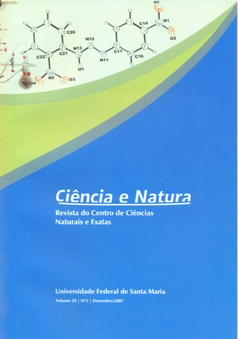Dinâmica do Carbono Inorgânico Dissolvido nos Rios Teles Pires e Cristalino na Bacia Amazônica
DOI:
https://doi.org/10.5902/2179460X9880Resumo
Os rios têm importante papel no ciclo do carbono, seja nos fluxosevasivos de CO2 ou como exportadores de carbono para os oceanos. Medidasdiretas de trocas de CO2 entre os ecossistemas terrestres e a atmosferadevem considerar os fluxos dos sistemas aquáticos, para não superestimaro acúmulo terrestre de carbono. A bacia Amazônica forma o maior e maiscomplexo sistema de água doce do mundo, tendo conseqüentemente umimportante papel no ciclo global de carbono. O objetivo deste trabalho foiavaliar, no período compreendido entre os meses de setembro de 2004 aagosto de 2005, a dinâmica do carbono inorgânico dissolvido total (CID) esuas frações (CO2 dissolvido + HCO3- + CO32-) nas águas dos rios TelesPires e Cristalino, componentes da bacia amazônica, no município de AltaFloresta, MT. Quinzenalmente foram determinadas as concentrações deCID, pH e temperatura dos rios. Com base nessas determinações e aplicandoas equações de equilíbrio termodinâmico, estimou-se a pCO2 e asfrações do sistema de carbonatos. Os rios apresentaram variação sazonalnos valores de pH, sendo estes mais próximos da neutralidade no períododa seca. A concentração de HCO3- foi significativamente maior no perío116Ciência e Natura, UFSM, 29(2): 115 - 127, 2007do da seca do que no período da cheia. Ambos os rios estudados apresentaram-se sempre supersaturados de CO2 em relação atmosfera.Downloads
Downloads
Publicado
Como Citar
Edição
Seção
Licença
Para acessar a DECLARAÇÃO DE ORIGINALIDADE E EXCLUSIVIDADE E CESSÃO DE DIREITOS AUTORAIS clique aqui.
Diretrizes Éticas para Publicação de Revistas
A revista Ciência e Natura está empenhada em garantir a ética na publicação e na qualidade dos artigos.
A conformidade com padrões de comportamento ético é, portanto, esperada de todas as partes envolvidas: Autores, Editores e Revisores.
Em particular,
Autores: Os Autores devem apresentar uma discussão objetiva sobre a importância do trabalho de pesquisa, bem como detalhes e referências suficientes para permitir que outros reproduzam as experiências. Declarações fraudulentas ou intencionalmente incorretas constituem comportamento antiético e são inaceitáveis. Artigos de Revisão também devem ser objetivos, abrangentes e relatos precisos do estado da arte. Os Autores devem assegurar que seu trabalho é uma obra totalmente original, e se o trabalho e / ou palavras de outros têm sido utilizadas, isso tem sido devidamente reconhecido. O plágio em todas as suas formas constitui um comportamento publicitário não ético e é inaceitável. Submeter o mesmo manuscrito a mais de um jornal simultaneamente constitui um comportamento publicitário não ético e é inaceitável. Os Autores não devem submeter artigos que descrevam essencialmente a mesma pesquisa a mais de uma revista. O Autor correspondente deve garantir que haja um consenso total de todos os Co-autores na aprovação da versão final do artigo e sua submissão para publicação.
Editores: Os Editores devem avaliar manuscritos exclusivamente com base no seu mérito acadêmico. Um Editor não deve usar informações não publicadas na própria pesquisa do Editor sem o consentimento expresso por escrito do Autor. Os Editores devem tomar medidas de resposta razoável quando tiverem sido apresentadas queixas éticas relativas a um manuscrito submetido ou publicado.
Revisores: Todos os manuscritos recebidos para revisão devem ser tratados como documentos confidenciais. As informações ou ideias privilegiadas obtidas através da análise por pares devem ser mantidas confidenciais e não utilizadas para vantagens pessoais. As revisões devem ser conduzidas objetivamente e as observações devem ser formuladas claramente com argumentos de apoio, de modo que os Autores possam usá-los para melhorar o artigo. Qualquer Revisor selecionado que se sinta desqualificado para rever a pesquisa relatada em um manuscrito ou sabe que sua rápida revisão será impossível deve notificar o Editor e desculpar-se do processo de revisão. Os Revisores não devem considerar manuscritos nos quais tenham conflitos de interesse resultantes de relacionamentos ou conexões competitivas, colaborativas ou outras conexões com qualquer dos autores, empresas ou instituições conectadas aos documentos.






